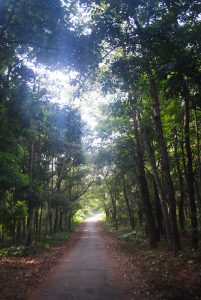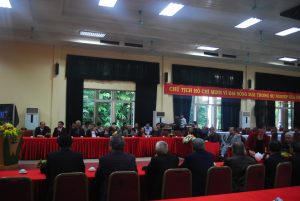On 15 May 2018, Vietnam Forestry Club (VFC) in collaboration with Vietnam Forestry University and Vietnam Forestry University held a workshop on ” Environmental Forestry Development in Vietnam: Opportunities, Challenges and Solutions “. The workshop was attended by over 100 participants, including representatives from the Government Office, leaders from the Vietnam Administration of Forestry (VNFOREST), the Vietnam Forestry University (VFU), the Forestry Project Management Board, the Forest Science Institute of Vietnam, Institute of Forest Inventory and Planning, Vietnam Forest Protection and Development Fund, Forest Protection and Development Funds of Ha Giang, Thua Thien Hue, and Bidoup – Nui Ba National Park, Phong Nha – Ke Bang National Park, Vietnam Timber and Forest Product Association (VIFORES), Vietnam Forestry Association, Vietnam Association for Water Resources Research, Sub forester clubs of Thua Thien Hue, Bac Ninh, Quang Nam and Bac Kan, Sustainable Forest Management Institute and Forest Certification and Nghe An Center for Forestry Development. The workshop was also welcomed representative of workshop donor of Ms. Nguyen Thi Thu Huyen, a National Coordinator of the Small Grants Program, Global Environment Facility.

Before listening to the reports and discussing in the hall, the delegates went to visit the experimental forest of Vietnam Forestry University (VFU) and enjoying the musical performance by the students to welcome the participants. The workshop included 20 reports, including 9 reports have been presented at the workshop and rest others printed in the handout delivering for all delegates. Workshop topics divided into three sections, including (1) Identification of Environmental Forestry; (2) Pay for Forest Environmental Services (PFES) and monitor forest assets and values; (3) Solutions and Policies for the Development of Environmental Forestry.
Reports presented in the workshop have showed various aspects that are supporting environmental forestry in Vietnam. How is environmental forestry and how is forest value calculated; the payment for forest environment service (PFES) in practice of Vietnam and especially in the case of Bidoup Nui Ba National Park in Lam Dong Province (one of first two sites of PFES); information technology application in PFES in Hue province; Environmental forest oriented wood industry of Vietnam; and current situation and lessons learn of environmental forestry in the world and recommendation of developing environmental forestry in Vietnam.
Prof., Dr. Pham Van Dien, Vice Director of VNFOREST, said that environmental forest is forestry that its value have been made by maintaining and nurturing and restoring beneficial functions of forest. The values of forest include valuations of ecosystem and forest products (timber and non-forest products), and ecosystem valuation is a key factor. Prof., Dr. Pham Van Dien set an example of ecosystem valuation calculation in several countries and its function providing oxy was the most valuable than others (almost equal to total of other functions) which has been calculated in Japan. Therefore, from example of Japan, it is simple to understand that environmental forestry is oxygen selling forest sector (forest business to sale oxygen).

Prof., Dr. Pham Van Dien rose 4 issues to build environmental forestry:
- How much benefits and losses is forest losing? And how it could be distributed?
- Either valuable service of environmental forest or forest products to collect?
- What are policies to balance benefits and costs to ensure to keep forest?
- Monitoring property as environmental forest value? Issues relating technical and technology?
For the current situation of environment forestry in Vietnam, Mr Ngo Sy Hoai, General Secretary of Vietnam Forester Club (VFC), said that Vietnam should mobilize internal power of people for environment forest development in the country. The success in implementing PFES, which was total VND 1,709 billion in 2017 (equivalent to USD 0.7 per capital) to serve to compensate the efforts to forest protection by people living in the watershed areas, was an internal power mobilization.
Recommendations:
- Environmental forestry development, by calculating the values of eco-environmental system that forest provides, is an inevitable trend in context of climate change rasing in Vietnam. Although, it has been facing many challenges, Vietnam forestry has been early favarable condition for environmental forest development. Payment for forest environment system (PFES) and REDD+ readiness preparation being the first steps towards to environmental forestry development in Vietnam
- Ban on natural forest logging has been issued by Government meant that no logging over 10.2 million hectares of natural forest. Vietnam forest sector should enhance and develop innovative financing mechanism to invest into forest protection and development for the areas. For 84 thousand hectares of plantation forest as special use forest, the eco-environmental function of forest should be improved towards to carbon absorption. For 684 thousand hectares of plantation forest as protection forest should keep trees to meet REDD+ requirements. The 2.86 million hectares of plantation forest classified as production forest shall be kept rotation longer to take large-size wood to sustainably provide forest product (no threatening other functions of forest after each trade rotation).
- In the guidance of forest law, there should be necessary to develop requirement of payment for more objects including not only for hydro power plants, running water providers and eco-tourist servicers but also applying for industry and aquaculture facilities, and other entities of emitting green gas house. It is necessarily to build domestic carbon market to be similar with PES. Thermal power plants, steel production factories, and other facilities releasing carbon emission shall compensate for efforts to protect and develop forest through purchasing carbon credits.
- Income taking from PES should be considered as public income of forest and a financial contribution of forest sector to economy and this should be managed by forest sector. State forest owners shall be involved in provincial level management council of forest protection and development fund.
- Funds taking from PES should be served for forest conservation activities in the national parks and natural conservation area but not focusing mainly on watershed forest protection as recently. State forest owners should make partially self-finance through income of PES instead of depending deeply on state budget.
- Effective monitoring mechanism of PES is needed and the various criteria should be developed to assess effectiveness of PES. PES and REDD+ and compensation mechanism of natural resource should be integrated to raise funds.
- Information technology applying in PES should be boosted. High-tech application (remote sensing tech, information tech) should be used to support inspection process of distribution of fund of PES.
- Vietnam forestry sector should strengthen communication and policy advocacy to reach consensuses and supports of public society for new final mechanism for environmental forestry development.
Cao Thanh – Vice Secretary General of VFC



